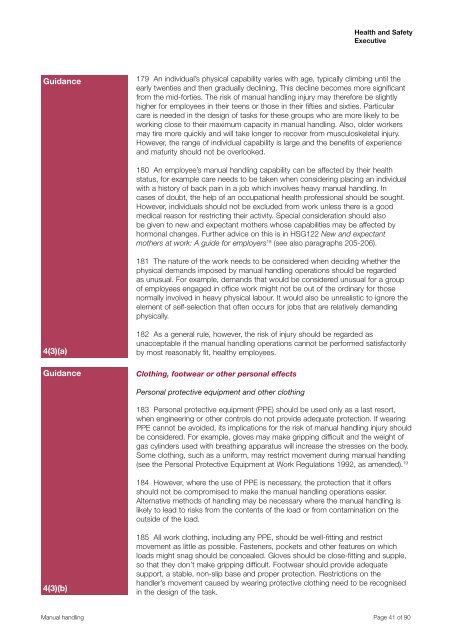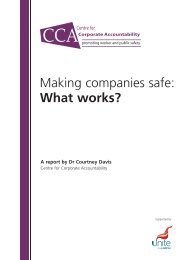Manual Handling Manual Handling Operations Regulations 1992 ...
Manual Handling Manual Handling Operations Regulations 1992 ...
Manual Handling Manual Handling Operations Regulations 1992 ...
Create successful ePaper yourself
Turn your PDF publications into a flip-book with our unique Google optimized e-Paper software.
Health and Safety<br />
Executive<br />
Guidance<br />
179 An individual’s physical capability varies with age, typically climbing until the<br />
early twenties and then gradually declining. This decline becomes more significant<br />
from the mid-forties. The risk of manual handling injury may therefore be slightly<br />
higher for employees in their teens or those in their fifties and sixties. Particular<br />
care is needed in the design of tasks for these groups who are more likely to be<br />
working close to their maximum capacity in manual handling. Also, older workers<br />
may tire more quickly and will take longer to recover from musculoskeletal injury.<br />
However, the range of individual capability is large and the benefits of experience<br />
and maturity should not be overlooked.<br />
180 An employee’s manual handling capability can be affected by their health<br />
status, for example care needs to be taken when considering placing an individual<br />
with a history of back pain in a job which involves heavy manual handling. In<br />
cases of doubt, the help of an occupational health professional should be sought.<br />
However, individuals should not be excluded from work unless there is a good<br />
medical reason for restricting their activity. Special consideration should also<br />
be given to new and expectant mothers whose capabilities may be affected by<br />
hormonal changes. Further advice on this is in HSG122 New and expectant<br />
mothers at work: A guide for employers 18 (see also paragraphs 205-206).<br />
181 The nature of the work needs to be considered when deciding whether the<br />
physical demands imposed by manual handling operations should be regarded<br />
as unusual. For example, demands that would be considered unusual for a group<br />
of employees engaged in office work might not be out of the ordinary for those<br />
normally involved in heavy physical labour. It would also be unrealistic to ignore the<br />
element of self-selection that often occurs for jobs that are relatively demanding<br />
physically.<br />
4(3)(a)<br />
Guidance<br />
182 As a general rule, however, the risk of injury should be regarded as<br />
unacceptable if the manual handling operations cannot be performed satisfactorily<br />
by most reasonably fit, healthy employees.<br />
Clothing, footwear or other personal effects<br />
Personal protective equipment and other clothing<br />
183 Personal protective equipment (PPE) should be used only as a last resort,<br />
when engineering or other controls do not provide adequate protection. If wearing<br />
PPE cannot be avoided, its implications for the risk of manual handling injury should<br />
be considered. For example, gloves may make gripping difficult and the weight of<br />
gas cylinders used with breathing apparatus will increase the stresses on the body.<br />
Some clothing, such as a uniform, may restrict movement during manual handling<br />
(see the Personal Protective Equipment at Work <strong>Regulations</strong> <strong>1992</strong>, as amended). 19<br />
184 However, where the use of PPE is necessary, the protection that it offers<br />
should not be compromised to make the manual handling operations easier.<br />
Alternative methods of handling may be necessary where the manual handling is<br />
likely to lead to risks from the contents of the load or from contamination on the<br />
outside of the load.<br />
4(3)(b)<br />
185 All work clothing, including any PPE, should be well-fitting and restrict<br />
movement as little as possible. Fasteners, pockets and other features on which<br />
loads might snag should be concealed. Gloves should be close-fitting and supple,<br />
so that they don’t make gripping difficult. Footwear should provide adequate<br />
support, a stable, non-slip base and proper protection. Restrictions on the<br />
handler’s movement caused by wearing protective clothing need to be recognised<br />
in the design of the task.<br />
<strong>Manual</strong> handling Page 41 of 90
















